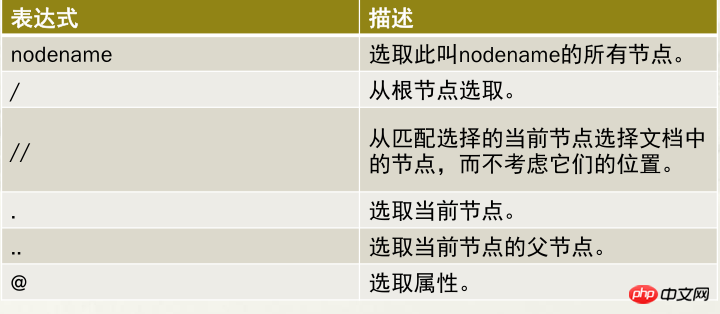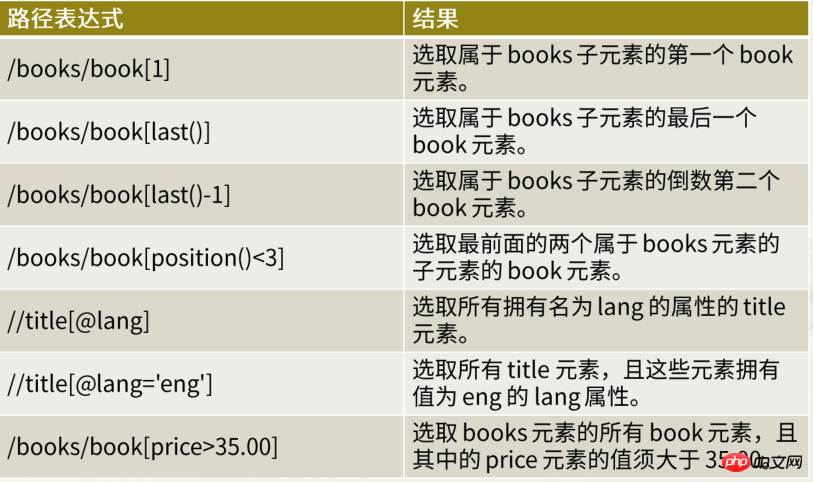What is XML? Example explanation of xml
Directory structure:
1 What is XML
XML (eXtensible markup language) is an extensible markup language, even The language of labels can be customized.
2 Parsing XML
2.1 Two ways of parsing
XML parsing is divided into two ways, namely SAX and DOM.
DOM: (Document Object Model) is a way of processing XML recommended by the W3C organization. Using this method to parse XML documents will construct a tree structure in memory according to the hierarchical relationship between all elements in the document. Therefore, it puts a lot of pressure on memory and is slow to parse and read. The advantage is that it can traverse and modify the contents of nodes.
SAX: (Simple API for XML) is an alternative to XML parsing. Compared with DOM, the parsing speed is faster and the memory pressure is less; the disadvantage is that the content of the node cannot be modified.
2.2 Use dom4j to parse XML
Before using dom4j to parse XML, you need to import relevant tool packages, such as the author's: dom4j-1.6.1.jar Package
2.2.1 dom4j API
//创建SAXReader,是dom4j包提供的解析器SAXReader reader=new SAXReader();//读取指定的文件Document doc=reader.read(new File(filename)); Document Document getRootElement() 用于获取根元素 Element Element element(String name) 获取元素下指定名称的子元素 List<Element> elements() 获取元素下所有的子元素 String getName() 获取元素名 String getText() 获取元素文本内容 String elementText(String name) 获取子元素文本内容 Attribute attribute(String) 获取元素的属性 String attributeValue(String name) 获取元素的属性值 Attribute String getName() 获取属性的名字 String getValue() 获取属性的值
2.2.2 Print the entire contents of an XML file
The pricties.xml file is located directly under the project


<?xml version="1.0" encoding="utf-8" ?><books id="a"> <book id="b"><name id="c_1" name="c_2">三国演绎</name><author id="d_1" name="d_2" >罗贯中</author><price id="e">58.8</price> </book> <book id="f_1" name="f_2"><name id="g">水浒传</name><author id="h">施耐庵</author><price id="i">49.8</price> </book> <book id="j_1" name="j_2"><name id="k">西游记</name><author id="l">吴承恩</author><price id="m">100.1</price><order>1</order> </book></books>


import java.io.File;import java.util.List;import org.dom4j.Attribute;import org.dom4j.Document;import org.dom4j.Element;import org.dom4j.io.SAXReader;public class ParseXML {public static void main(String[] args) {//创建SAXReader对象SAXReader saxr=new SAXReader();
Document docu=null;try{//读取指定的文件,相对于项目路径docu=saxr.read(new File("pricties.xml"));//获得元素的文件的根节点Element e=docu.getRootElement();
searchAllElement(e);
}catch(Exception e){
e.printStackTrace();
}
} public static void searchAllElement(Element e){//获得当前元素下的所有子元素,并存储到集合中List<Element> elements=e.elements();
System.out.print("<"+e.getName());//打印开始标记List<Attribute> atrs=e.attributes();//打印该标记下的所有属性for(Attribute att:atrs){
System.out.print(" "+att.getName()+"=\""+att.getValue()+"\"");
}
System.out.println(">"); //如果集合的大小为0,表示该集合下没有子元素了if(elements.size()==0){
System.out.println(e.getText());//打印文本信息System.out.println("</"+e.getName()+">");//打印结束标记return;//退出当前层方法 } //递归每一个子元素for(Element ele:elements){
searchAllElement(ele);
}
System.out.println("</"+e.getName()+">");//打印结束标记 }
}2.3 Apply XPath to parse XML in dom4j
First, you need to introduce the corresponding jar package based on dom4j, such as the reader's: jaxen-1.1-beta-6. jar
2.3.1 XPath API
Document List<Node> selectNodes(String xpath) Node selectSingleNode(String xpath)
2.3.2 XPath的路径表达式
2.3.2.1 XPath的路径表达式规则

2.3.2.2 XPath的路径表达式应用案例

2.3.3 通配符
2.3.3.1 通配符规则

2.3.3.2 通配符应用案例

2.3.4 谓语
2.3.4.1 谓语规则
谓语是用来查找某个特定的节点或是包含某个指定的值的节点
谓语被嵌在方括号中
2.3.4.2 谓语应用案例

3 java写XML文件
3.1 将一个带有书籍信息的List集合解析为XML文件


package com.xdl.xml;public class Book {private String name;private String author;private String price;public Book() {super();
}public Book(String name, String author, String price) {super();
setName(name);
setAuthor(author);
setPrice(price);
}/** * @return the name */public String getName() {return name;
}/** * @param name the name to set */public void setName(String name) {this.name = name;
}/** * @return the author */public String getAuthor() {return author;
}/** * @param author the author to set */public void setAuthor(String author) {this.author = author;
}/** * @return the price */public String getPrice() {return price;
}/** * @param price the price to set */public void setPrice(String price) {this.price = price;
}
}

package com.xdl.xml;import java.io.File;import java.io.FileNotFoundException;import java.io.FileOutputStream;import java.io.IOException;import java.util.ArrayList;import java.util.List;import org.dom4j.Document;import org.dom4j.DocumentHelper;import org.dom4j.Element;import org.dom4j.io.XMLWriter;public class WriteXML {public static void main(String[] args) {//创建一个Book集合用于存储书籍信息List<Book> list_books=new ArrayList<Book>();//插入书籍信息for(int i=0;i<6;i++){
Book book=new Book("jame"+i,"author"+i,""+i);
list_books.add(book);
} //创建一个文档对象Document doc=DocumentHelper.createDocument();//创建一个根节点Element books=DocumentHelper.createElement("books"); //获得书籍集合的大小int size=list_books.size();for(int i=0;i<size;i++){//创建一个book节点Element book=books.addElement("book");//创建一个name节点Element name=book.addElement("name");//创建一个author节点Element author=book.addElement("author");//创建一个price节点Element price=book.addElement("price");
name.setText(list_books.get(i).getName());
author.setText(list_books.get(i).getAuthor());
price.setText(list_books.get(i).getPrice());
}//设置文档根节点 doc.setRootElement(books); try {//如果文件不存在,会自动创建FileOutputStream fos = new FileOutputStream(new File("books.xml"));
XMLWriter xmlw = new XMLWriter(fos);
xmlw.write(doc);
xmlw.close();
} catch (FileNotFoundException e) {
e.printStackTrace();
} catch (IOException e) {
e.printStackTrace();
}
}
}4 Schema和DTD的区别
Schema是对XML文档结构的定义和描述,其主要的作用是用来约束XML文件,并验证XML文件有效性。DTD的作用是定义XML的合法构建模块,它使用一系列的合法元素来定义文档结构。它们之间的区别有下面几点:
1、Schema本身也是XML文档,DTD定义跟XML没有什么关系,Schema在理解和实际应用有很多的好处。
2、DTD文档的结构是“平铺型”的,如果定义复杂的XML文档,很难把握各元素之间的嵌套关系;Schema文档结构性强,各元素之间的嵌套关系非常直观。
3、DTD只能指定元素含有文本,不能定义元素文本的具体类型,如字符型、整型、日期型、自定义类型等。Schema在这方面比DTD强大。
4、Schema支持元素节点顺序的描述,DTD没有提供无序情况的描述,要定义无序必需穷举排列的所有情况。Schema可以利用xs:all来表示无序的情况。
5、对命名空间的支持。DTD无法利用XML的命名空间,Schema很好满足命名空间。并且,Schema还提供了include和import两种引用命名空间的方法。
5 参考文章
Schema和DTD的区别
The above is the detailed content of What is XML? Example explanation of xml. For more information, please follow other related articles on the PHP Chinese website!

Hot AI Tools

Undresser.AI Undress
AI-powered app for creating realistic nude photos

AI Clothes Remover
Online AI tool for removing clothes from photos.

Undress AI Tool
Undress images for free

Clothoff.io
AI clothes remover

Video Face Swap
Swap faces in any video effortlessly with our completely free AI face swap tool!

Hot Article

Hot Tools

Notepad++7.3.1
Easy-to-use and free code editor

SublimeText3 Chinese version
Chinese version, very easy to use

Zend Studio 13.0.1
Powerful PHP integrated development environment

Dreamweaver CS6
Visual web development tools

SublimeText3 Mac version
God-level code editing software (SublimeText3)

Hot Topics
 1386
1386
 52
52
 Detailed explanation of obtaining administrator rights in Win11
Mar 08, 2024 pm 03:06 PM
Detailed explanation of obtaining administrator rights in Win11
Mar 08, 2024 pm 03:06 PM
Windows operating system is one of the most popular operating systems in the world, and its new version Win11 has attracted much attention. In the Win11 system, obtaining administrator rights is an important operation. Administrator rights allow users to perform more operations and settings on the system. This article will introduce in detail how to obtain administrator permissions in Win11 system and how to effectively manage permissions. In the Win11 system, administrator rights are divided into two types: local administrator and domain administrator. A local administrator has full administrative rights to the local computer
 Detailed explanation of the mode function in C++
Nov 18, 2023 pm 03:08 PM
Detailed explanation of the mode function in C++
Nov 18, 2023 pm 03:08 PM
Detailed explanation of the mode function in C++ In statistics, the mode refers to the value that appears most frequently in a set of data. In C++ language, we can find the mode in any set of data by writing a mode function. The mode function can be implemented in many different ways, two of the commonly used methods will be introduced in detail below. The first method is to use a hash table to count the number of occurrences of each number. First, we need to define a hash table with each number as the key and the number of occurrences as the value. Then, for a given data set, we run
 Detailed explanation of division operation in Oracle SQL
Mar 10, 2024 am 09:51 AM
Detailed explanation of division operation in Oracle SQL
Mar 10, 2024 am 09:51 AM
Detailed explanation of division operation in OracleSQL In OracleSQL, division operation is a common and important mathematical operation, used to calculate the result of dividing two numbers. Division is often used in database queries, so understanding the division operation and its usage in OracleSQL is one of the essential skills for database developers. This article will discuss the relevant knowledge of division operations in OracleSQL in detail and provide specific code examples for readers' reference. 1. Division operation in OracleSQL
 Detailed explanation of remainder function in C++
Nov 18, 2023 pm 02:41 PM
Detailed explanation of remainder function in C++
Nov 18, 2023 pm 02:41 PM
Detailed explanation of the remainder function in C++ In C++, the remainder operator (%) is used to calculate the remainder of the division of two numbers. It is a binary operator whose operands can be any integer type (including char, short, int, long, etc.) or a floating-point number type (such as float, double). The remainder operator returns a result with the same sign as the dividend. For example, for the remainder operation of integers, we can use the following code to implement: inta=10;intb=3;
 Detailed explanation of the usage of Vue.nextTick function and its application in asynchronous updates
Jul 26, 2023 am 08:57 AM
Detailed explanation of the usage of Vue.nextTick function and its application in asynchronous updates
Jul 26, 2023 am 08:57 AM
Detailed explanation of the usage of Vue.nextTick function and its application in asynchronous updates. In Vue development, we often encounter situations where data needs to be updated asynchronously. For example, data needs to be updated immediately after modifying the DOM or related operations need to be performed immediately after the data is updated. The .nextTick function provided by Vue emerged to solve this type of problem. This article will introduce the usage of the Vue.nextTick function in detail, and combine it with code examples to illustrate its application in asynchronous updates. 1. Vue.nex
 Detailed explanation of php-fpm tuning method
Jul 08, 2023 pm 04:31 PM
Detailed explanation of php-fpm tuning method
Jul 08, 2023 pm 04:31 PM
PHP-FPM is a commonly used PHP process manager used to provide better PHP performance and stability. However, in a high-load environment, the default configuration of PHP-FPM may not meet the needs, so we need to tune it. This article will introduce the tuning method of PHP-FPM in detail and give some code examples. 1. Increase the number of processes. By default, PHP-FPM only starts a small number of processes to handle requests. In a high-load environment, we can improve the concurrency of PHP-FPM by increasing the number of processes
 Detailed explanation of the role and usage of PHP modulo operator
Mar 19, 2024 pm 04:33 PM
Detailed explanation of the role and usage of PHP modulo operator
Mar 19, 2024 pm 04:33 PM
The modulo operator (%) in PHP is used to obtain the remainder of the division of two numbers. In this article, we will discuss the role and usage of the modulo operator in detail, and provide specific code examples to help readers better understand. 1. The role of the modulo operator In mathematics, when we divide an integer by another integer, we get a quotient and a remainder. For example, when we divide 10 by 3, the quotient is 3 and the remainder is 1. The modulo operator is used to obtain this remainder. 2. Usage of the modulo operator In PHP, use the % symbol to represent the modulus
 Detailed explanation of the linux system call system() function
Feb 22, 2024 pm 08:21 PM
Detailed explanation of the linux system call system() function
Feb 22, 2024 pm 08:21 PM
Detailed explanation of Linux system call system() function System call is a very important part of the Linux operating system. It provides a way to interact with the system kernel. Among them, the system() function is one of the commonly used system call functions. This article will introduce the use of the system() function in detail and provide corresponding code examples. Basic Concepts of System Calls System calls are a way for user programs to interact with the operating system kernel. User programs request the operating system by calling system call functions




